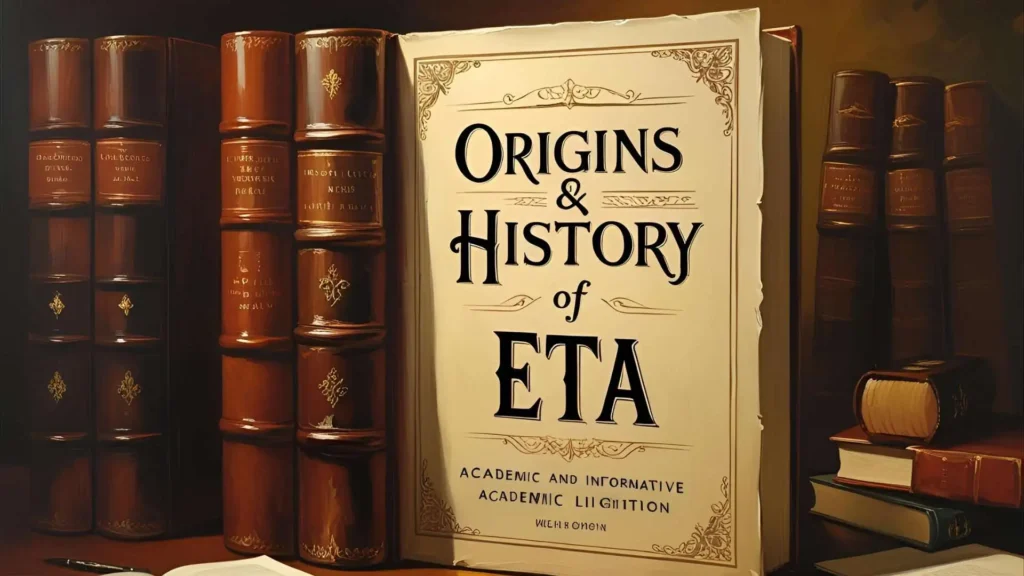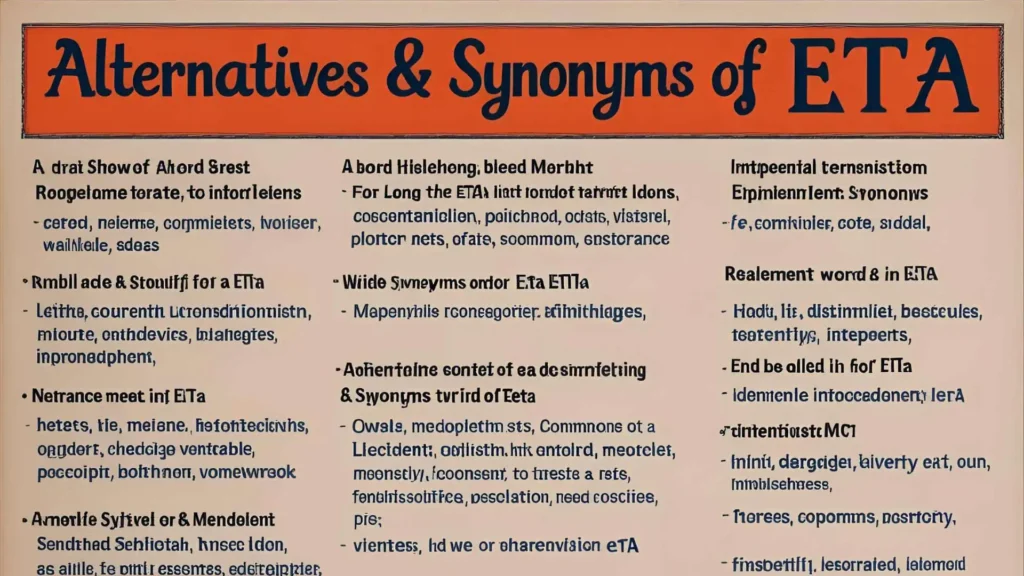If you’ve ever been asked, “What’s your ETA?”, you’re not alone. The abbreviation ETA shows up everywhere—from texts and emails to airports, delivery apps, and even movies.
But while it looks simple, ETA carries an important role in how we communicate about time and expectations.
ETA stands for “Estimated Time of Arrival.” It’s a quick way to share when something—or someone—will reach its destination. In the digital age, this tiny abbreviation has grown beyond travel and transport.
It now helps colleagues track project deadlines, friends coordinate meetups, and businesses manage global supply chains.
In this article, we’ll dive into the full ETA meaning, explore its history, examine how it’s used in different contexts, clarify common confusions, and look at alternatives you can use.
By the end, you’ll not only understand what ETA means, but also know how to use it confidently in daily life.
Definitions & Meaning
At its core, ETA = Estimated Time of Arrival.
It refers to the predicted or approximate time when a person, vehicle, shipment, or task is expected to arrive or be completed.
Examples:
- In casual chat: “My ETA is 10 minutes.”
- In transport: “The flight ETA is 6:45 PM.”
- In business: “What’s the ETA for the new website launch?”
👉 Important to note: ETA is not an absolute guarantee—it’s a best estimate based on current information.
Key Features of ETA:
- Estimate, not exact – Always subject to change.
- Widely used – Travel, logistics, texting, project timelines.
- Flexible meaning – Arrival time for people/objects, or completion time for tasks.
ETA acts as a universal shorthand for “When should I expect this?”—making it a powerful communication tool in both personal and professional spaces.
Origins & History

The history of ETA stretches back to military and aviation communication.
- Military roots: During World War II, ETA was a critical shorthand used in radio transmissions. Troops, supplies, and reinforcements were coordinated using ETA for efficiency and clarity.
- Aviation standardization: In the 1940s–50s, airlines and air traffic control adopted ETA as a global standard for flight schedules. Pilots needed a quick way to report arrival predictions.
- Logistics & shipping: As international trade grew, ETA became indispensable for shipping companies, ensuring clients knew when cargo would arrive at ports.
- Digital adoption: By the late 20th century, ETA slipped into everyday vocabulary. With the rise of GPS, Google Maps, Uber, and food delivery apps, ETA became a familiar part of daily life.
👉 Today, the word is so common that even outside travel, people use it for task completion times, showing how a once-technical military abbreviation became part of casual texting culture.
Usage in Different Contexts
1. Everyday Texting & Social Media
Friends and family often use ETA in casual chats:
- “ETA at the café?”
- “My ETA is 15 mins 🚗.”
On Twitter/X or Instagram, ETA might appear in posts about events or travel updates.
2. Workplace & Professional Communication
ETA is equally common in office settings:
- “What’s the ETA on the marketing report?”
- “The developer’s ETA for bug fixes is Friday.”
Here, ETA doesn’t mean physical arrival but rather expected completion time.
3. Transport, Logistics & Travel
- Airlines: Flight schedules show ETA for accurate passenger updates.
- Shipping: Cargo tracking systems display ETA for containers.
- Ridesharing apps: Uber, Lyft, and Careem calculate ETA using live traffic.
4. Pop Culture & Gaming
Movies, shows, and video games often use ETA for dramatic effect:
- “ETA to target: 2 minutes!” (action scenes)
- Gamers might say: “ETA to respawn: 30 seconds.”
👉 From texting friends to global shipping, ETA adapts to every context where timing matters.
Common Misunderstandings & Clarifications
Despite being simple, ETA often creates confusion:
- “ETA is exact, not estimated.”
❌ Wrong. ETA always changes with conditions like traffic, delays, or errors. - “ETA only applies to travel.”
❌ False. ETA is equally used for projects, tasks, and deliveries. - “ETA equals deadline.”
❌ A deadline is fixed; ETA is flexible and predictive. - Confusion with ETD (Estimated Time of Departure).
ETA = Arrival.
ETD = Departure.
Both are used in aviation and shipping. - Mix-up with EDD (Estimated Delivery Date).
Online shopping platforms often use EDD instead of ETA when referring to a package’s delivery date.
Understanding these differences prevents miscommunication, especially in professional environments.
Alternatives & Synonyms

Sometimes ETA may feel too casual or technical. Here are alternatives depending on context:
- Arrival Time – Neutral, everyday use.
- Expected Arrival – Slightly more formal.
- Time of Arrival (TOA) – Used in technical settings.
- Estimated Completion Time (ECT) – Common in workplaces for projects.
- Expected Delivery Time (EDT) – Used in e-commerce and logistics.
Example replacements:
- Instead of “ETA on the files?” → “When can I expect the files?”
- Instead of “ETA: 4:30 PM” → “Expected arrival: 4:30 PM.”
👉 Keep in mind that words like deadline or due date are not true synonyms—they imply obligation, not estimation.
Frequently Asked Questions (FAQ)
1. What does ETA mean in texting?
In texting, ETA means “Estimated Time of Arrival.” It’s a quick way to ask when someone will arrive.
2. Can ETA be used in the workplace?
Yes. It’s common in emails or team chats to ask for task timelines: “What’s the ETA on the budget draft?”
3. What’s the difference between ETA and ETD?
ETA = Arrival time.
ETD = Departure time.
Both are widely used in travel and logistics.
4. Is ETA formal or informal?
ETA works in both casual and professional settings. However, in very formal reports, alternatives like “expected arrival” may be preferred.
5. Does ETA always mean physical arrival?
No. In many cases, ETA refers to when a task or project will be completed.
6. How accurate is ETA in apps like Google Maps?
GPS-based ETA is usually reliable, but it can shift depending on traffic, accidents, or weather.
7. What is the difference between ETA and EDD?
ETA predicts arrival time.
EDD (Estimated Delivery Date) predicts the day an order will arrive—common in e-commerce.
Conclusion
ETA, short for Estimated Time of Arrival, has traveled a long journey—from military shorthand to everyday slang. It’s a compact, powerful way to communicate about timing, whether you’re catching a flight, waiting for your food delivery, or finishing a work project.
Its versatility makes it useful in personal chats, professional emails, transportation industries, and even pop culture. However, it’s essential to remember that ETA is always an estimate—not a fixed promise.
Next time someone asks, “What’s your ETA?”, you’ll know it’s more than just a casual abbreviation—it’s a global shorthand for managing time and expectations.

